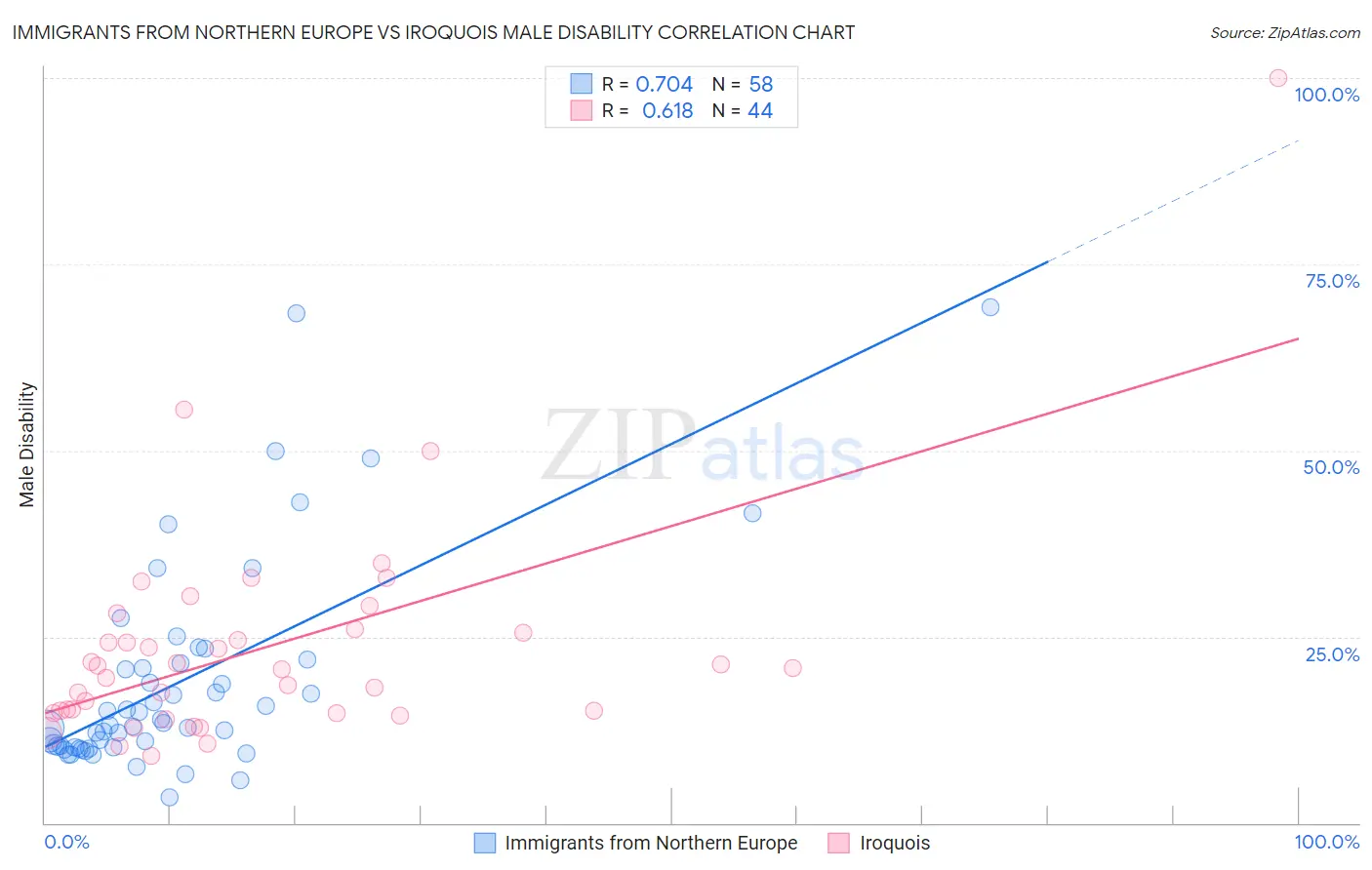Immigrants from Northern Europe vs Iroquois Male Disability
COMPARE
Immigrants from Northern Europe
Iroquois
Male Disability
Male Disability Comparison
Immigrants from Northern Europe
Iroquois
11.1%
MALE DISABILITY
73.2/ 100
METRIC RATING
153rd/ 347
METRIC RANK
13.6%
MALE DISABILITY
0.0/ 100
METRIC RATING
315th/ 347
METRIC RANK
Immigrants from Northern Europe vs Iroquois Male Disability Correlation Chart
The statistical analysis conducted on geographies consisting of 477,177,667 people shows a strong positive correlation between the proportion of Immigrants from Northern Europe and percentage of males with a disability in the United States with a correlation coefficient (R) of 0.704 and weighted average of 11.1%. Similarly, the statistical analysis conducted on geographies consisting of 207,273,711 people shows a significant positive correlation between the proportion of Iroquois and percentage of males with a disability in the United States with a correlation coefficient (R) of 0.618 and weighted average of 13.6%, a difference of 22.7%.

Male Disability Correlation Summary
| Measurement | Immigrants from Northern Europe | Iroquois |
| Minimum | 3.4% | 9.0% |
| Maximum | 69.2% | 100.0% |
| Range | 65.8% | 91.0% |
| Mean | 19.0% | 23.4% |
| Median | 13.3% | 20.7% |
| Interquartile 25% (IQ1) | 10.2% | 14.9% |
| Interquartile 75% (IQ3) | 21.4% | 25.8% |
| Interquartile Range (IQR) | 11.2% | 11.0% |
| Standard Deviation (Sample) | 14.2% | 15.2% |
| Standard Deviation (Population) | 14.1% | 15.0% |
Similar Demographics by Male Disability
Demographics Similar to Immigrants from Northern Europe by Male Disability
In terms of male disability, the demographic groups most similar to Immigrants from Northern Europe are Immigrants from Moldova (11.1%, a difference of 0.020%), Immigrants from Albania (11.0%, a difference of 0.090%), Cuban (11.0%, a difference of 0.12%), Immigrants from Guatemala (11.0%, a difference of 0.14%), and Immigrants from Middle Africa (11.1%, a difference of 0.16%).
| Demographics | Rating | Rank | Male Disability |
| Koreans | 77.5 /100 | #146 | Good 11.0% |
| Immigrants | Croatia | 77.3 /100 | #147 | Good 11.0% |
| Sudanese | 77.1 /100 | #148 | Good 11.0% |
| Immigrants | Denmark | 76.4 /100 | #149 | Good 11.0% |
| Immigrants | Guatemala | 75.1 /100 | #150 | Good 11.0% |
| Cubans | 74.9 /100 | #151 | Good 11.0% |
| Immigrants | Albania | 74.4 /100 | #152 | Good 11.0% |
| Immigrants | Northern Europe | 73.2 /100 | #153 | Good 11.1% |
| Immigrants | Moldova | 72.8 /100 | #154 | Good 11.1% |
| Immigrants | Middle Africa | 70.9 /100 | #155 | Good 11.1% |
| Russians | 69.8 /100 | #156 | Good 11.1% |
| Immigrants | Western Africa | 69.2 /100 | #157 | Good 11.1% |
| Latvians | 68.1 /100 | #158 | Good 11.1% |
| Guatemalans | 67.2 /100 | #159 | Good 11.1% |
| Albanians | 66.5 /100 | #160 | Good 11.1% |
Demographics Similar to Iroquois by Male Disability
In terms of male disability, the demographic groups most similar to Iroquois are Alaska Native (13.6%, a difference of 0.050%), Aleut (13.5%, a difference of 0.16%), Puget Sound Salish (13.5%, a difference of 0.22%), Yakama (13.5%, a difference of 0.24%), and Delaware (13.5%, a difference of 0.79%).
| Demographics | Rating | Rank | Male Disability |
| French American Indians | 0.0 /100 | #308 | Tragic 13.4% |
| Blackfeet | 0.0 /100 | #309 | Tragic 13.4% |
| Immigrants | Azores | 0.0 /100 | #310 | Tragic 13.4% |
| Delaware | 0.0 /100 | #311 | Tragic 13.5% |
| Yakama | 0.0 /100 | #312 | Tragic 13.5% |
| Puget Sound Salish | 0.0 /100 | #313 | Tragic 13.5% |
| Aleuts | 0.0 /100 | #314 | Tragic 13.5% |
| Iroquois | 0.0 /100 | #315 | Tragic 13.6% |
| Alaska Natives | 0.0 /100 | #316 | Tragic 13.6% |
| Paiute | 0.0 /100 | #317 | Tragic 13.7% |
| Cree | 0.0 /100 | #318 | Tragic 13.7% |
| Americans | 0.0 /100 | #319 | Tragic 13.8% |
| Tlingit-Haida | 0.0 /100 | #320 | Tragic 13.8% |
| Shoshone | 0.0 /100 | #321 | Tragic 13.8% |
| Apache | 0.0 /100 | #322 | Tragic 14.0% |